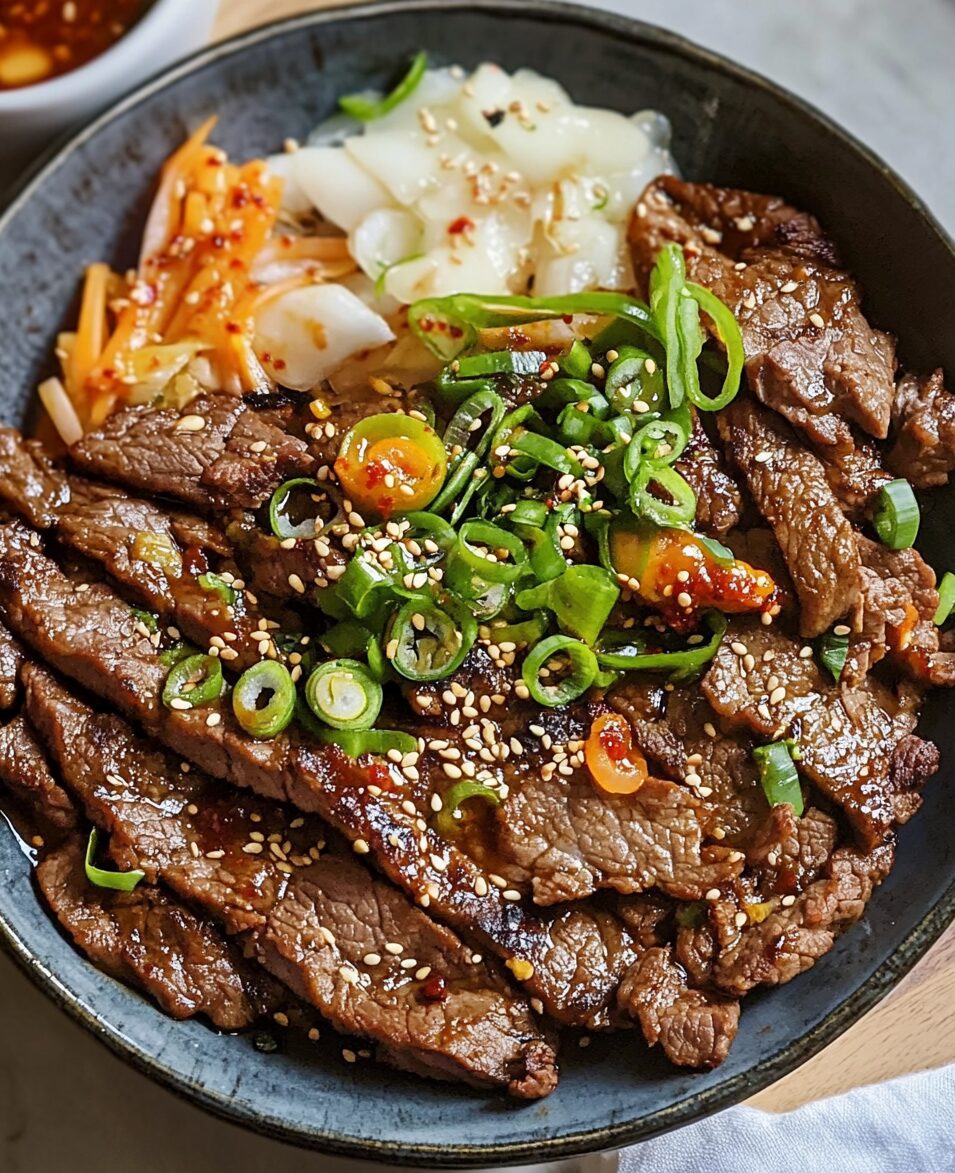Beef Bulgogi is a Korean BBQ classic known for its tender, flavorful marinated beef. The sweet and savory combination of soy sauce, sesame oil, garlic, and ginger makes each bite burst with umami. Quick to cook, it’s a great option for busy weeknights or casual gatherings with friends.
Traditionally served with steamed rice and various side dishes, this dish can be prepared on a grill or in a pan. Whether you’re new to Korean cuisine or a seasoned pro, Beef Bulgogi is a must-try recipe that brings a taste of authentic Korean flavors to your table.
Full Recipe
Ingredients:
- 1 pound beef sirloin, thinly sliced
- 1/4 cup soy sauce
- 2 tablespoons sesame oil
- 1 tablespoon sugar
- 1 tablespoon minced garlic
- 1 tablespoon minced ginger
- 2 tablespoons sesame seeds
- 1/4 cup chopped green onions
- 1 teaspoon black pepper
- 1/4 cup water
- 1 tablespoon vegetable oil
Directions:
- In a large bowl, mix together soy sauce, sesame oil, sugar, garlic, ginger, sesame seeds, green onions, and black pepper.
- Add the thinly sliced beef to the marinade, stirring to coat. Cover and refrigerate for at least 1 hour, or overnight for deeper flavor.
- Heat vegetable oil in a large skillet or grill pan over medium-high heat.
- Cook the marinated beef in batches, ensuring that the slices are evenly spread out in the pan. Sear each side for 1-2 minutes, or until browned and cooked through.
- Serve the Beef Bulgogi with steamed rice, and garnish with additional sesame seeds or green onions if desired.
Prep Time: 15 minutes | Marinating Time: 1 hour | Cooking Time: 10 minutes | Total Time: 1 hour 25 minutes
Kcal: 280 kcal | Servings: 4 servings
Nutritional Benefits
Beef Bulgogi is a nutritionally balanced dish that offers a mix of protein, healthy fats, and essential vitamins and minerals. Here are some key nutritional aspects of this recipe:
- High Protein Content: Made with beef sirloin, which is a lean cut, Beef Bulgogi is an excellent source of protein, essential for muscle growth, tissue repair, and overall body function. A typical serving provides around 20-25 grams of protein.
- Rich in Essential Vitamins and Minerals: Beef provides important nutrients such as iron, zinc, and B vitamins, including B12, which supports red blood cell production and brain function. Iron is vital for preventing anemia, and zinc boosts immune function.
- Healthy Fats: The sesame oil used in the marinade offers healthy fats, particularly monounsaturated and polyunsaturated fats, which are beneficial for heart health. These fats help lower bad cholesterol levels and support cell function.
- Antioxidants and Anti-inflammatory Properties: The ingredients in the marinade, like garlic and ginger, are rich in antioxidants and have anti-inflammatory properties. These can help reduce oxidative stress in the body, promoting overall health and reducing the risk of chronic diseases.
- Low-Carb Option: Beef Bulgogi is naturally low in carbohydrates, especially if paired with low-carb sides like lettuce wraps or vegetables. This makes it suitable for those following low-carb or ketogenic diets.
History and Origin of Beef Bulgogi
Beef Bulgogi has its roots in Korean culinary traditions that date back over 1,000 years. The term “Bulgogi” translates to “fire meat,” referring to the grilling process used to cook the marinated beef. Historically, Bulgogi was enjoyed by Korean royalty during the Goguryeo era (37 BC–668 AD) and has evolved over time to become a beloved dish in both royal and common households.
Bulgogi was initially cooked over open flames or charcoal, giving the meat a distinct smoky flavor. The preparation has evolved to use modern appliances like stovetop grills and pans, but the essential ingredients and marination techniques remain largely the same. The sweet and savory flavor profile comes from soy sauce, sugar, sesame oil, and aromatic ingredients like garlic and ginger. These ingredients were once rare commodities, which contributed to Bulgogi’s reputation as a luxurious dish.
In contemporary Korean culture, Bulgogi is a staple dish, often prepared for special occasions or family gatherings. It is typically served with steamed rice and side dishes called “banchan,” which may include kimchi, pickled vegetables, and seasoned greens. The dish’s versatility allows it to be adapted for home cooking or for upscale dining experiences.
Cultural Significance of Beef Bulgogi
Beef Bulgogi is more than just a dish in Korean culture; it symbolizes community, hospitality, and celebration. In Korea, meals are often shared communally, and grilling meats like Bulgogi at the table fosters a sense of togetherness. It’s a common feature at gatherings, festivals, and holidays, where sharing food strengthens social bonds.
One unique aspect of Korean cuisine is the balance of flavors and textures. Bulgogi, with its marinated meat, provides a savory umami base that complements a variety of side dishes (banchan), such as kimchi (fermented vegetables), japchae (stir-fried glass noodles), and various pickled and sautéed vegetables. This balance reflects the Korean philosophy of harmony and wellness, which is central to their food culture.
In Korean BBQ restaurants, Bulgogi is often grilled at the table, allowing diners to enjoy the sizzle and aroma of the meat as it cooks. The interactive nature of Korean BBQ, with guests wrapping Bulgogi in lettuce leaves and topping it with different condiments, makes it a fun, hands-on dining experience.
Modern Adaptations and Variations
With globalization and the spread of Korean cuisine, Beef Bulgogi has seen numerous adaptations worldwide. Chefs and home cooks alike have put their own spin on the dish while keeping its core essence intact.
- Vegan and Vegetarian Versions: As plant-based diets grow in popularity, many are creating vegan versions of Bulgogi by substituting beef with ingredients like mushrooms, tofu, or seitan. These alternatives can mimic the texture and absorb the flavorful marinade just as well as traditional beef.
- Fusion Dishes: Bulgogi has been incorporated into Western cuisines in exciting ways. For example, Bulgogi tacos, Bulgogi burgers, and even Bulgogi pizzas are popular in fusion restaurants. These dishes blend the savory-sweet flavors of Bulgogi with other global flavors, creating new, creative experiences.
- Healthier Versions: With a growing interest in health-conscious eating, lighter versions of Bulgogi are being developed. Using leaner cuts of beef, reducing sugar in the marinade, and incorporating more vegetables in the dish are just a few ways the recipe has been modified to meet modern dietary preferences.
Serving Suggestions for Beef Bulgogi
Traditionally, Bulgogi is served with steamed white rice and an array of banchan. To elevate the meal, here are some additional serving suggestions:
- Lettuce Wraps (Ssam): A popular way to enjoy Bulgogi is by wrapping the grilled beef in lettuce leaves (often accompanied by perilla leaves) and adding condiments like ssamjang (a thick, savory paste made from soybean and chili paste) and fresh garlic or chili slices. The crisp lettuce provides a refreshing contrast to the tender meat.
- Rice Bowls: Serve Bulgogi over a bed of rice with a fried egg on top and a variety of vegetables like sautéed spinach, carrots, and mushrooms to create a Bulgogi rice bowl, similar to bibimbap. This makes for a hearty and visually appealing dish.
- Noodles: Bulgogi pairs wonderfully with chewy noodles. You can add Bulgogi to japchae (Korean sweet potato noodles) or use it as a topping for ramen or udon for a more comforting, soupy meal.
- Side Dishes: Accompany Bulgogi with kimchi, cucumber salad, or miso soup for an authentic Korean dining experience. The contrast of flavors—spicy, tangy, and sweet—brings out the complexity of the Bulgogi marinade.
Conclusion
Beef Bulgogi is more than just a delicious meal—it’s a nutrient-dense dish that supports your body with high-quality protein, essential vitamins, and healthy fats. Its rich history, dating back to ancient Korean royalty, adds cultural depth to the experience of enjoying this dish. Whether you’re trying Korean cuisine for the first time or looking for a flavorful, nutritious dinner, Beef Bulgogi offers a perfect balance of tradition, taste, and health benefits.






